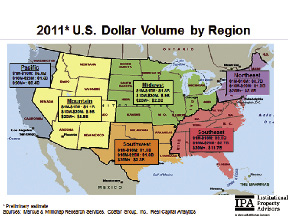The improving economic and commercial real estate readings of the past few months continue to foster an encouraging outlook for 2012. Last month's strong job performance put total private-sector employment growth for the past 12 months at just under 2.3 million. It seems companies are becoming more confident and cutting fewer workers as illustrated by the four-year low in first-time unemployment applications. Growing reliance on permanent full-time positions offers yet another data point that validates rising corporate confidence.
For example, in 2010, temporary jobs accounted for one-third of net jobs created. That ratio fell to 9% in 2011, indicating the need for companies to commit to full-time, long-term workers thanks to improving corporate financial conditions.
Another pivotal bright spot for the economy has been exports, which grew 5.1% over the past year and accounted for 13% of total economic output. Growth in trade continues to underlie somewhat of a manufacturing revival in the U.S., resulting in 235,000 additional manufacturing jobs in the past 12 months. As we anticipated last year amid the renewed concerns of a double-dip recession, the U.S. economy steadily shifted out of neutral and back into expansion mode. Leading indicators point to a continuation of this trend or better as 2012 unfolds.
Mixed news on the macro front continues. Just as concerns regarding Europe began to ease thanks to the recent Greek bail out, rising tensions in the Middle East have pressured energy prices. Further disruptions in the Middle East could send energy prices spiraling much higher than the already elevated levels. In short, negative global headwinds will continue to hamper economic growth in the U.S., but the balance now tilts toward a more robust recovery, absent any major shock. Longer term, consumer de-leveraging and reduction of public debt will also keep growth rates below potential, but the good news is that the U.S. will experience a period of solid growth in 2012 and 2013.
Economic momentum is sure to boost demand for commercial space across the board. Improved corporate confidence and hiring provide critical indicators that companies are entering an expansionary period. Each property type will have a defining theme this year. Apartments will continue to outpace other sectors, particularly as long as young adults capture about 60% of new jobs. Sub-themes for apartments include favorable demographics, release of pent-up demand, and new supply levels that are sure to fall short of demand for at least another year. In the case of retail, expanding retailers will continue to outpace waning store closures by a wider margin, lending an extra boost to already respectable levels of net absorption. Fortunately, speculative retail construction remains at multi-decade lows. The theme behind industrial properties centers on growing exports and the tight correlation between retail sales and the movement of goods, simply pointing to the best year of net absorption in five years. Finally, the nearly 600,000 professional and business services jobs created in the last 12 months would appear to offer an optimistic backdrop for the office recovery this year. Notwithstanding the improvement in net absorption that should materialize this year, the office sector is likely to remain "the laggard" once again. Companies simply have too much excess space and those renewing leases are looking for efficiency and cost control. A broader and more robust level of net absorption will remain elusive until prosperity extends to small and mid-sized companies as much as it has to large multi-nationals.
Steve Witten is senior director of the Institutional Property Advisors Group of Marcus and Millichap based in New Haven, Conn. He can be reached at switten@ipausa.com.
Tags:
Improving economic and commercial real estate readings foster an encouraging outlook for 2012
March 15, 2012 - Connecticut










